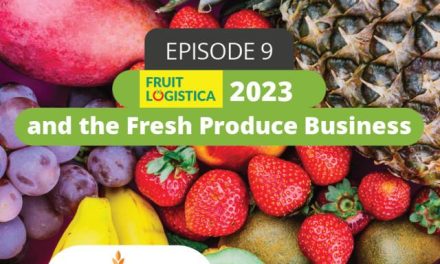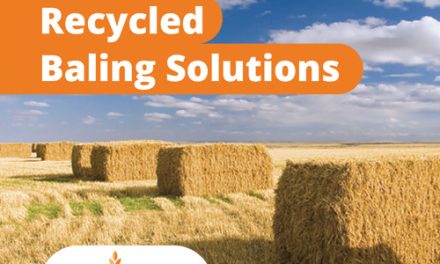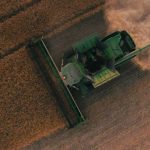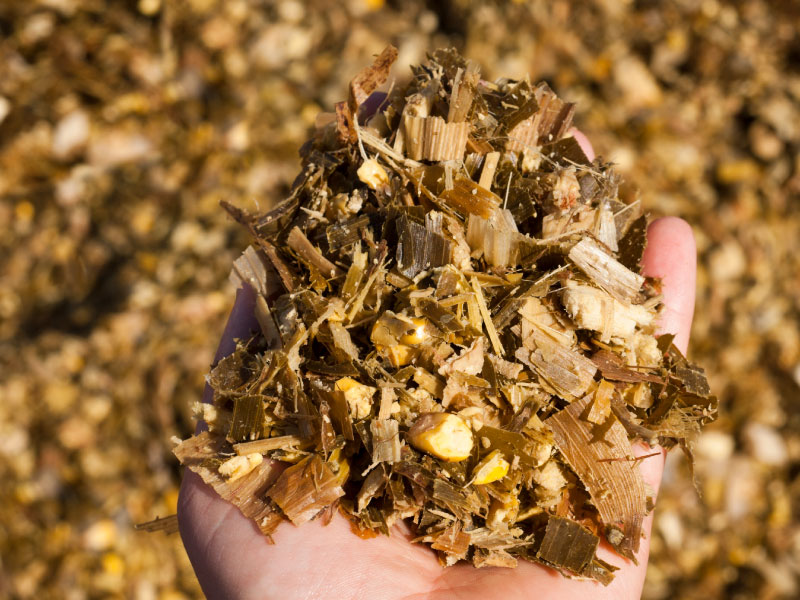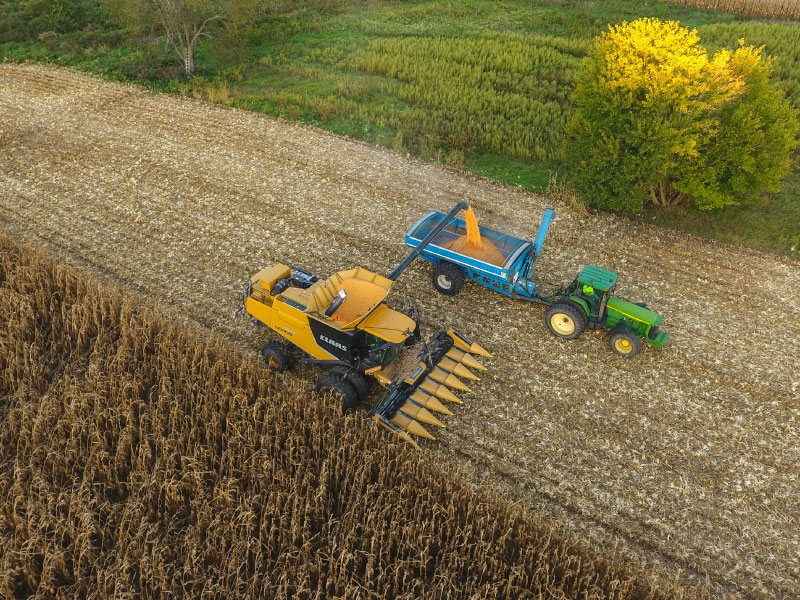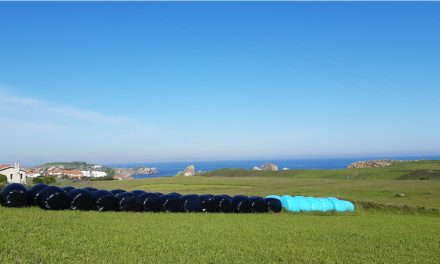
Maximizing silage yields with microbial inoculants

Microbial inoculants are an effective feed additive based on the use of bacteria to improve silage yield and crop quality, and silage is essential to preserve forage quality.
By assisting in the fermentation of silage, which is the anaerobic process for the preservation of forage crops with adequate moisture, these bacteria provide a much more nutritious feed for livestock feeding.
As a general recommendation, it is very important to always consider the instructions of the inoculant’s manufacturer because each one will have greater efficacy in different forages.
It is also necessary to consider that these inoculants should be applied to the forage before ensiling, while the forage should be well chopped so that the inoculated bacteria can come into contact with as much of the surface area as possible.
Why should microbial inoculants be used?
According to Renato J. Schmidt, an agronomist and animal scientist specialized in technological services and forage products at Lallemand Animal Nutrition, when we talk about aerobic fermentation, there are aspects that directly affect the forage mass. This is the case with oxygen, which negatively affects the process, becoming the worst enemy of silage.
“While this is a natural process, because when we go to the field and cut the plant or forage to be stored, even if it is covered, in the best of cases in a way it is already colonized by a wide range of microbes, since many of them are present in the air. Some are usually beneficial and others not so much, so we cannot be sure what we are taking into the silage process. This is the first reason to use inoculants,” says Schmidt.
Schmidt points out that by using microbial inoculants for silage, it is possible to contribute to prolonging the preservation of the nutritional value of the forage, while the fermentation process is significantly improved by the enzymes and microorganisms that influence it, especially in silages made of grasses, legumes, corn, and other types of forages.
By using the right microbial inoculants, the following is possible:
- Introduce the appropriate microbes that will control the silage fermentation process.
- Control the sugars needed for fermentation.
- Obtain a good moisture level.
- Obtain better quality forage that’s more stable.
The outcome of the fermentation process is determined by the dominant species of microbes in the silage
“The fermentation process is basically a war in which microbes do all the work. There are good players, such as lactic acid bacteria that are divided into heterofermentative and homofermentative, which allow high levels of dry matter to be achieved. There are also bad players such as molds, fungi, yeasts, enterobacteria, and clostridia, undesirable microbes that can cause ketosis and a lot of dry matter loss,” explains Schmidt.
Understanding that to achieve maximum dry matter recovery (DMR) in the fermentation process, we need an initial fermentation that is mainly homolactic is essential. The reason behind it is that these homolactic bacteria will use glucose and fructose which will end up producing lactic acids. The increase in acidity will minimize the amount of dry matter lost.
According to information published on the website of the University of Wisconsin’s Extension Division, microbial silage inoculants are divided into two categories (homofermenters and heterofermenters), which respond to how they ferment the common plant sugar (glucose or fructose).
What is the main goal of microbial inoculants?
Certainly, the main goal is to improve the rate of fermentation quickly to lower the pH as quickly as possible, minimize forage respiration, prevent bad fermentations, and thus maximize nutrient conservation. In this way, a higher recovery of dry matter, protein, and energy is achieved.
“Generally, positive results are obtained with the use of microbial inoculants, since we are using beneficial microbes that will help us with fermentation. However, the magnitude of the response obtained can vary because we are not always certain which microbes are in some forages. Some microbes are easier to combat than others, which is why we have to be vigilant about it,” Schmidt explains.
Microbial inoculants are mostly used for the following purposes:
- To prevent clostridial fermentation, especially in alfalfa crops and wet winter pastures, and achieve rapid pH lowering by inhibiting the activity of undesirable microbes.
- To improve aerobic stability, for example, in corn silage.
- To optimize good fermentation to improve dry matter levels and recover nutrients.
Among other benefits of using microbial inoculants in silage is that they improve silage digestibility, which translates into greater nutrient absorption by livestock.
“It should be emphasized that microbial silage inoculants are not a substitute for good management or good handling of the silage process, i.e., just because you use an inoculant that has proven to be effective during ensilaging, doesn’t mean that you shouldn’t have good hygiene, that you don’t practice proper storage or that you don’t comply with the processes the right way. All steps are equally important,” adds Schmidt.
For more information and other interesting data about this topic, we recommend reading our article entitled studies show how silage bags efficiently maintain the quality of grain storage.
Recommendations for handling and applying microbial inoculants:
- Follow label instructions on how to dilute and how to mix everything. Store liquid inoculants in the fridge if instructions say so – some inoculants are alive and need to be stored in a fridge.
- Use clean water without chemicals for mixing the silage inoculant
- Disinfect, clean, and calibrate all applicators periodically.
- Apply evenly on all forage particles so that microbial inoculants can thrive throughout the forage.
- Remember that microbes are living organisms, so they need to be protected from heat, solar radiation, and moisture.
- Choose an effective inoculant. To do this, it is important to look for published research on them, check the reputation of the manufacturer and distributor, and know that not all inoculants are the same. If necessary, seek technical support, carry out quality controls, and avoid getting carried away by considering cost as a decision factor.
- Discard unused water mixed inoculants at the end of the day, do not store it for the next day.
What is the impact of undesirable microbes on silage fermentation?
- They inhibit and compete with beneficial microbes.
- They degrade proteins, sugars, starch and fibre.
- They produce undesirable compounds and heat the silage.
- They decrease dry matter and energy recovery, reducing the nutritive value of the silage.
- They increase the probability of health risks for animals and humans.
What is the problem with homolactic fermentation?
Low pH alone won’t inhibit the growth of yeasts when farmers remove the feed from storage because when we remove the feed, the silo bag or silage clamp (wherever we store that feed) will be open and oxygen will begin to penetrate the forage mass. In this case, the yeasts will become active, and the low pH won’t help much, as the yeasts will start using lactic acid as a food source, thus initiating the process of silage spoilage and heating.
“In this scenario, what we need is to stop the growth of yeasts, which cause 99% of all heating, spoilage, and waste events,” Schmidt points out.
How can you improve the aerobic stability of silages with Lactobacillus buchneri 40788?
The use of the lactic acid bacteria, Lactobacillus buchneri 40788 (a heterofermentative lactic acid bacteria) was a turning point in improving aerobic stability in silage, especially when removing the feed from storage and stabilizing the silage due to the problems already mentioned.
By using this bacteria in silage we achieve the following:
- A moderate increase in acetic acid.
- Lower yeast and molds.
- To provide improved silage shelf life at the storage site.
- Less dry matter loss during the feed removal process.
- To maintain silage stability and hygiene.
Inoculation with L. buchneri 40788 is more effective for treating forage, or where the silage is stored, than with propionic acid, which is also widely known and used.
When should an L. buchneri product be used?
First, it’s worth mentioning that care should be taken with inoculation when the forage is very wet, i.e., when the dry matter is below 30% or 35%. Always consult your nutritionist if you are unable to wait for the correct dry matter. L. buchneri can be used in a wide variety of scenarios It should be noted that this inoculant acts as an insurance policy that will prevent future problems. Once the fermentation has gone down the wrong pathway it cannot be reversed. If the silage is spoiled, it cannot be treated afterwards.
“It can be used to make sure that the silage will be in good condition, and that the amount of dry matter recovery will be ideal. Otherwise, it can be used when the farmer has already had a history of problems either with heating, yeast, and fungal growth or with other difficult scenarios such as soil contamination,” according to Schmidt.
It is always important to remember that, although the acetic acid produced by Lactobacillus buchneri slows the growth of molds and yeasts that cause silage deterioration and heating, special care must be taken in how the silage is handled in the following cases:
- If crops are very dry.
- If proper sealing is lacking.
- If storage density is low.
- If there is a low feed outflow rate, among others.
For further information, we recommend reading our article on how to prevent white mold in silage bales.
Benefits of combining homofermentative and heterofermentative microbial inoculants
Experts in the field point out that combinations of these inoculants are recommended for a variety of reasons:
- A good fermentation process is guaranteed.
- There is a higher recovery of dry matter.
- Higher acetic acid concentration and better aerobic stability than with a homofermentative inoculant alone.
- A much faster pH reduction is achieved.
What challenges do fresh forages face during the ensiling process?
At this point, it is important to consider that each forage has specific characteristics. Therefore, having the advice of experts in the field is necessary.
In the case of forages that have a high protein level, as well as a low sugar and dry matter content, they tend to acidify very slowly, which causes the protein to degrade, and the nutritional value to be lower.
On the contrary, when silages have a high level of dry matter and sugars, they tend to show a high aerobic instability, which opens the way for the development of degrading microorganisms.
When one of these possible scenarios occurs and there is no plan or strategy in place for proper control, the likelihood of a negative impact increases, not only regarding the economic value of the silage, but also concerning the welfare, efficiency, and performance of the animals on the farm.
When is the best time to apply microbial inoculants?
The best time is not something written in stone. Everything will depend on the type of crop, the method used to apply the inoculant, the chop length and the climatic conditions in each region.
In general, it is recommended to apply the inoculant as soon as possible after harvest or as close as possible to the point of compacting, i.e., when the forage is still fresh since the higher moisture and nutrient content will favor the growth of bacteria and fungi.
The most popular recommendation is to apply the inoculants just after chopping, which should be well-chopped so that the bacteria can be distributed more evenly throughout the forage.
If the forage is very wet, it will probably be necessary to dry it before applying the microbial inoculant, as this excess moisture can inhibit the growth of the bacteria in the inoculant.
What can affect the effectiveness of a microbial inoculant?
- The fact that insecticidal or fungicidal substances used on the plant may be toxic to the inoculating bacteria, hence the need for a compatibility test to verify that there is no risk of damage.
- The weather conditions when harvesting and ensiling. Too high temperature will cause stability to take longer, while rain introduces more bacteria to the surface of the silage pit. Rain also increases the risk of soil contamination in the silage.
- Ignoring or not following the manufacturer’s instructions and recommendations regarding the method of application and the amounts of inoculant to be used.
Do inoculants have any effect on mycotoxins?
According to Schmidt, microbial inoculants don’t affect mycotoxins as these originate in the field or during storage. “I don’t think there is any product or a microbial inoculant with this effect, if anything it could be an indirect effect of inoculation that reduces the population of yeasts and molds, so the ability to produce mycotoxins is suppressed.”
Also, Schmidt points out that there are mycotoxins that are produced during storage, as well as mycotoxins that are produced in the field. When you bring those mycotoxins in from the field, they are treated with different products, chemicals, or other biological solutions, but no study proves that these products help with mycotoxins.
For more information, we recommend reading our article on minimizing mycotoxin problems when it comes to storing animal food.
If you are interested in more information on the topic, including information on different studies conducted with microbial inoculants and the fermentation process, new microbial inoculants that even improve the effect of L. buchneri bacteria alone in stabilizing feed outflow from the storage site, we recommend watching our webinar on how to get the most out of your silage with microbial inoculants.
And also supplement the information by listening to our podcast episode on this same topic.
We also invite you to read our post on the importance of hay bale density to improve livestock nutrition.





![[eBook] Sustainability and water management](https://agriplasticscommunity.com/wp-content/uploads/8_550x310_ENG-440x264.png)
![[eBook Trends in Agriculture Plastics] Increasing use of biodegradable mulch](https://agriplasticscommunity.com/wp-content/uploads/550 × 310_2_ENG-440x264.png)
![[eBook Trends in Agriculture Plastics] Reducing the plastic used in the manufacture of agricultural films](https://agriplasticscommunity.com/wp-content/uploads/550 × 310_1_ENG-150x150.png)





